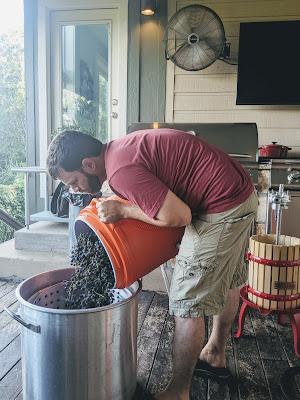Canyon Edge Lenoir grape harvest 2019!
This year, my parents, Allen and Donna Kirkland, joined us for our 5th annual grape harvest and stomp, and we had a blast, as always.
Like last year, we harvested on July 21st, which is a bit later than the first 3 years. Almost every viticulture-knowledgable person asks -- "why do you harvest so early?!?". Well, we get our bud burst in early March, and have fruit on the vines by the first week of May. I'd love to get our brix up a bit higher (this year, 18.2, whereas, 22 or 23 would be ideal). But the birds are already stealing our sweetest, best, darkest fruit. And any random day, we could have a deluge of 2 inches of rain from an unexpected summer thunderstorm, followed by 100F heat the next day, which would result in exploding grapes in a matter of hours (yes, this happened and we lost our vintage in 2014).
In any case, this year looked a lot like last year, in terms of the yield, specific gravity, acidity, and volume of juice.
We harvested about 43 lbs of fruit, putting it all into a big crawfish pot, and took turns stomping it. Last year, we destemmed, but this year we didn't. Next year, I think we'll destem again, as we definitely got a little more production. After the crushing, we lifted the inner basked and let some of the juice drain (about 2 gallons), and we took the mostly crushed fruit (including stems), and packed it into our press. Given the minimal skin contact, our final product ends up something like a dark rose, or perhaps an orange wine. So we cranked on the press, and churned out about another gallon of juice (call it a "first pressing" wine). The brix is, as always for us, a little lower than we'd like, this year clocking in at about 18.2. I'd much prefer 22 or 23, but as mentioned above, we risk losing the crop, if we got much deeper into the season. In any case, I used a chapitilzation calculator and stepped it up to 1.089 (22 brix) with about a pound of corn sugar in the 3 gallon batch. All of that is now in a stainless steel conical fermenter, with a packet of champagne yeast, happily fermenting away for a week or so. It'll ferment down to about .997 (so, 13.5% alcohol), and then we'll rack it to secondary. Eventually, we'll end up with an interesting, tart, dry, acidic, orange wine, that drinks more like a dry sherry or a wild fermented sour beer, but still probably quite different than anything you've ever had before!






































